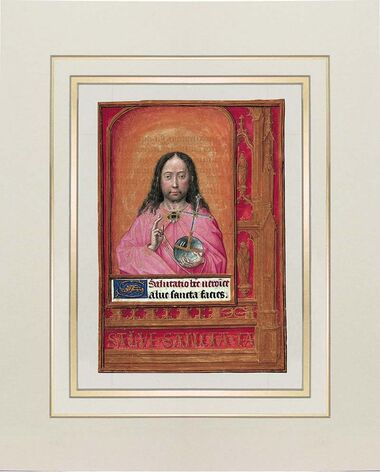
This lavish, ´quasi-original´ illumination of the Pantocrator is from the Hours of Joanna I of Castile, the original of which is held in London´s British Library. Our reproduction of this exquisite image comes with passe-partout, ready to be framed. With the passe-partout, it measures 252 x 303 mm.
Made on a special, parchment-style paper, this folio faithfully reproduces every aspect (colours, golds, textures, etc.) of the folios in the codex which once belonged to Queen Joanna I of Castile (the Mad). The reproduction is so identical it is impossible to distinguish it from the original.
This painting shows the Lord facing straight forwards, a detail that indicates his omniscience and importance. With his right hand he makes a Latin blessing, i.e. with his thumb, index finger and middle fingers outstretched in reference to the Holy Trinity, whilst his left hand grasps a large glass sphere divided into three parts by two gold bands in what is clearly a reference to the three known continents, in keeping with the Isidorian representations of the world based on the OT formula. Upon this sphere, in the part where Jerusalem would be, is a large, Greek cross with its centre and tips made of gold and embellished with emeralds and pearls. Depicted in the background is the luminous irradiation of the Lord. The portrait is surrounded by a narrow, golden, bevelled frame, with the rubric and the beginning of the prayer “Salutatio b[ea]te uero[n]ice/Salue sancta facies” written upon its lower part. The trompe-l’oeil technique makes the painting of the Saviour’s face stand out against an architectonic type of border reminiscent of a late Gothic reredos, featuring, alongside the pinnacles and beneath polylobulated arches, the representations of two martyred saints upon pedestals. The one at the top bears a spear and the one below, a sword. Beneath late Gothic tracery, written in letters formed by woody acanthus stems, is the beginning of the prayer to the holy face “salve · sancta · fac”.
Read more
Read less


This lavish, ´quasi-original´ illumination of the Pantocrator is from the Hours of Joanna I of Castile, the original of which is held in London´s British Library. Our reproduction of this exquisite image comes with passe-partout, ready to be framed. With the passe-partout, it measures 252 x 303 mm.
Made on a special, parchment-style paper, this folio faithfully reproduces every aspect (colours, golds, textures, etc.) of the folios in the codex which once belonged to Queen Joanna I of Castile (the Mad). The reproduction is so identical it is impossible to distinguish it from the original.
This painting shows the Lord facing straight forwards, a detail that indicates his omniscience and importance. With his right hand he makes a Latin blessing, i.e. with his thumb, index finger and middle fingers outstretched in reference to the Holy Trinity, whilst his left hand grasps a large glass sphere divided into three parts by two gold bands in what is clearly a reference to the three known continents, in keeping with the Isidorian representations of the world based on the OT formula. Upon this sphere, in the part where Jerusalem would be, is a large, Greek cross with its centre and tips made of gold and embellished with emeralds and pearls. Depicted in the background is the luminous irradiation of the Lord. The portrait is surrounded by a narrow, golden, bevelled frame, with the rubric and the beginning of the prayer “Salutatio b[ea]te uero[n]ice/Salue sancta facies” written upon its lower part. The trompe-l’oeil technique makes the painting of the Saviour’s face stand out against an architectonic type of border reminiscent of a late Gothic reredos, featuring, alongside the pinnacles and beneath polylobulated arches, the representations of two martyred saints upon pedestals. The one at the top bears a spear and the one below, a sword. Beneath late Gothic tracery, written in letters formed by woody acanthus stems, is the beginning of the prayer to the holy face “salve · sancta · fac”.
We use our own and third-party cookies to improve our services by analyzing your browsing habits. For more information, you can read our cookie policy. You can accept all cookies, configure them, or reject their use by clicking one of the buttons below.
Select which types of cookies you want to accept: